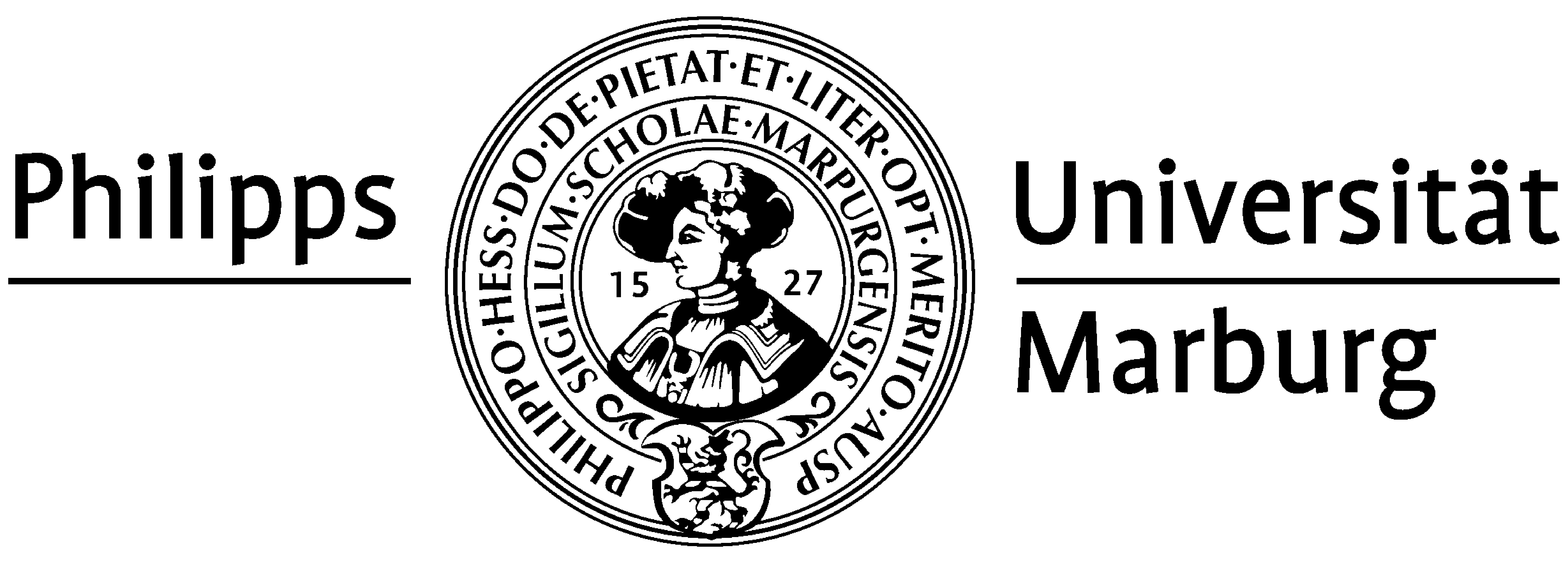News
February 2025
Detection of an interface-specific coherent phonon mode
Gerson Mette and co-workers succeed in exciting and detecting an interface-specific coherent phonon signal at the buried GaP/Si(001) heterointerface
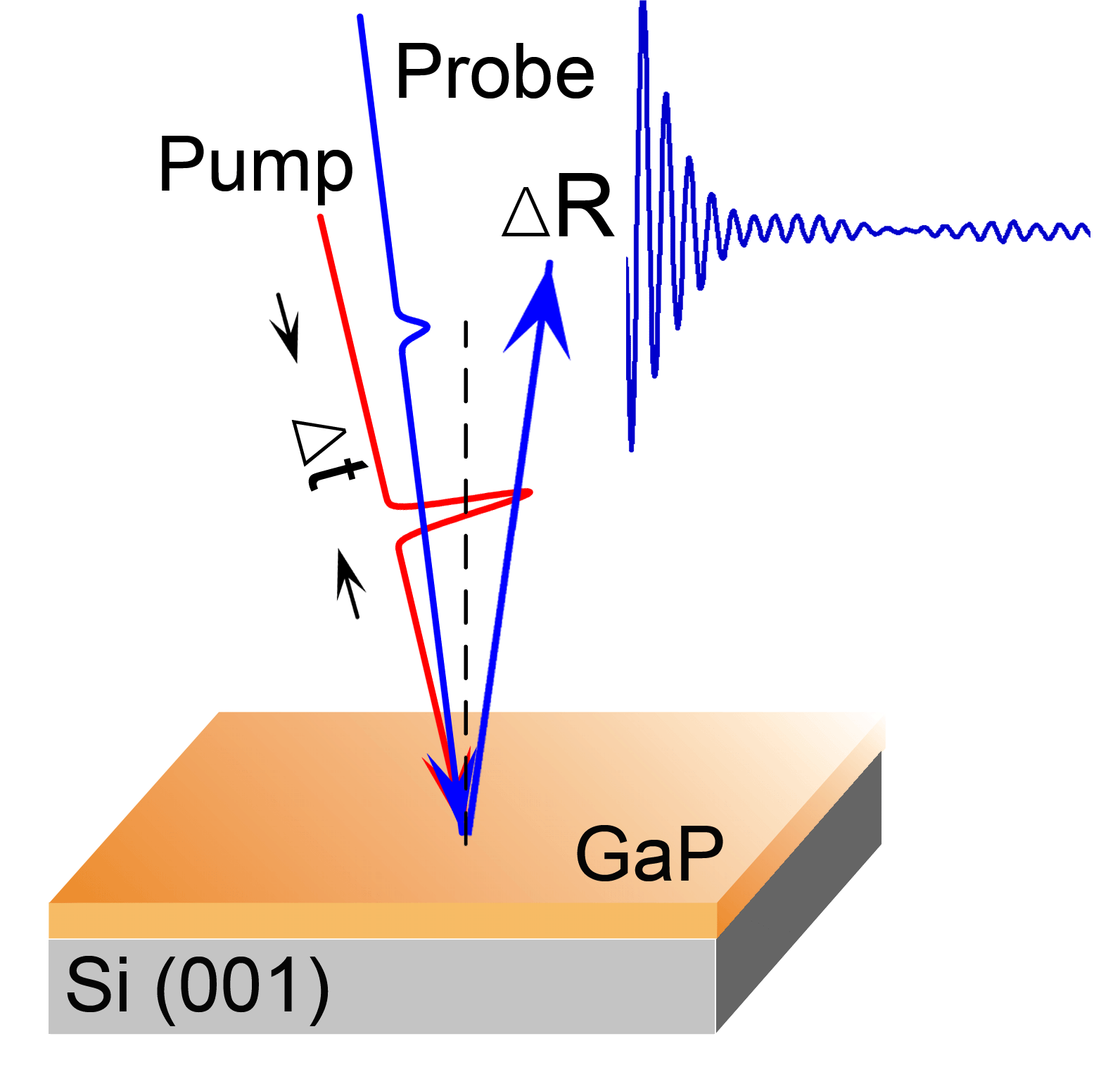 An important goal of the collaborative research centre SFB 1083 “Structure and Dynamics of Internal Interfaces” has been the advancement of the spectroscopy of buried interfaces. In this respect, the investigation of interface-specific phonons has proven to be most challenging. With the detection of a 2-THz difference-combination mode between a GaP-like and a Si phonon, Mette and coworkers could recently observe such an interface-specific vibrational excitation. The key to their success was a new laser experiment that we started setting up in 2019. With intense excitation pulses, which are at the same time short enough for coherent phonon spectroscopy and widely tunable, Mette et al. could launch the phonons by resonantly exciting an electronic interface transition. The work has been conducted in collaboration with Kunie Ishioka from the National Institute for Materials Science (NIMS) in Tsukuba, Japan. The samples were grown and characterized by Wolfgang Stolz and Kerstin Volz in Marburg.
An important goal of the collaborative research centre SFB 1083 “Structure and Dynamics of Internal Interfaces” has been the advancement of the spectroscopy of buried interfaces. In this respect, the investigation of interface-specific phonons has proven to be most challenging. With the detection of a 2-THz difference-combination mode between a GaP-like and a Si phonon, Mette and coworkers could recently observe such an interface-specific vibrational excitation. The key to their success was a new laser experiment that we started setting up in 2019. With intense excitation pulses, which are at the same time short enough for coherent phonon spectroscopy and widely tunable, Mette et al. could launch the phonons by resonantly exciting an electronic interface transition. The work has been conducted in collaboration with Kunie Ishioka from the National Institute for Materials Science (NIMS) in Tsukuba, Japan. The samples were grown and characterized by Wolfgang Stolz and Kerstin Volz in Marburg.
Publication:
G. Mette, K. Ishioka, S. Youngkin, W. Stolz, K. Volz, and U. Höfer,
„Interface‐specific excitation of coherent phonons at the buried GaP/Si(001) heterointerface“,
Adv. Mater. Interfaces, 2400573 (2025). DOI: 10.1038/s41586-023-05850-x
April 2023
Ultrafast birth, rise, and collapse of a Floquet-Bloch band structure
Suguru Ito and coworkers reveal that under strong periodic driving Floquet replica of electronic surface bands form already after one optical cycle. New material properties, at lightning speed and on demand – this vision moves a step closer thanks to these findings.

When electrons (spheres) are accelerated by strong light waves in the linearly dispersing surface state of Bi2Te3 (lowest cone), Floquet-Bloch replicas (higher cones) of the original band structure are formed. Videos of the band structure with sub-cycle time resolution reveal for the first time the formation dynamics (cones in the background).
Under strong periodic driving, the original electronic bands of a solid can split in evenly spaced Floquet-Bloch states, as if the original eigenstate of the electron dressed itself with several envelopes of light. In collaboration with the Huber group in Regensburg, Ito et al. succeeded in taking actual videos of the formation process of such exotic hybrid states between electrons and light. They accelerated electrons in the topologically protected Dirac surface state of Bi2Te3 with electric fields up to 1 MV/cm. ARPES measurements with a time-resolution better than a single oscillation cycle of the 25-40 THz driving pulses resulted in an unforeseen discovery, namely that Floquet-Bloch bands form already after a single optical cycle.
The surprisingly low fundamental time limit for light-induced material engineering paves the way to tailored quantum functionalities and ultrafast electronics. It is supported by theoretical modeling contributed by Michael Schüler of the Paul Scherrer Institute in Villigen, Switzerland, and Michael Sentef of the Max Planck Institute for Structure and Dynamics of Matter in Hamburg.
The work has been funded by the DFG through the SFB 1083 on „Structure and Dynamics of Internal Interfaces“.
Publication:
S. Ito, M. Schüler, M. Meierhofer, S. Schlauderer, J. Freudenstein, J. Reimann, D. Afanasiev, K. A. Kokh, O. E. Tereshchenko, J. Güdde, M. A. Sentef, U. Höfer, and R. Huber,
„Build-up and dephasing of Floquet-Bloch bands on subcycle timescales“,
Nature 616, 696 (2023). DOI: 10.1038/s41586-023-05850-x
Further information
Joint Press release of the Universities of Marburg and Regensburg (in German)
Dezember 2022
Science Slam Winner
Sarah Zajusch wins Science Slam in Cologne with a contribution on Two-Photon Photoemission from 2D semiconductors
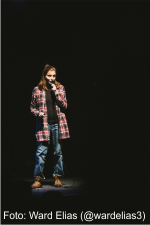 „Clear the stage for science!“ is the motto of the Science Slam network from Hamburg, which has been bringing scientists from all over Germany on stage for over 10 years. On 20.12.22, this motto became reality for Sarah Zajusch. In the sold-out concert hall „Gebäude 9“ in Cologne, she and four other „slammys“ had to inspire the audience within 10 minutes in a vivid and entertaining way about their own research. Under the title „Zwei Lichter und ein paar Elektronen in der (Halb-)Isolation” Sarah gave a short insight into Two-Photon Photoemission at 2D semiconductors and was chosen as the winner of the evening.
„Clear the stage for science!“ is the motto of the Science Slam network from Hamburg, which has been bringing scientists from all over Germany on stage for over 10 years. On 20.12.22, this motto became reality for Sarah Zajusch. In the sold-out concert hall „Gebäude 9“ in Cologne, she and four other „slammys“ had to inspire the audience within 10 minutes in a vivid and entertaining way about their own research. Under the title „Zwei Lichter und ein paar Elektronen in der (Halb-)Isolation” Sarah gave a short insight into Two-Photon Photoemission at 2D semiconductors and was chosen as the winner of the evening.
Her contribution can be seen on youtube https://www.youtube.com/watch?v=q5AXcVNKNHc.
November 2022
Poster Presentation Prize at DPT 2022 in Karlsruhe
Marleen Axt was awarded for the best poster presentation at the 26th German Conference of Women in Physics („Deutsche Physikerinnentagung“, DPT) in Karlsruhe
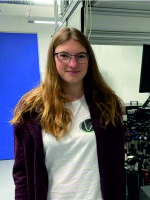 The German Conference of Women in Physics takes place annually since 1997. Supported by the German Physical Society (DPG), it offers female scientists of all areas of physics and at different carrier levels – from student to professor as well as physicists in industry – the possibility for networking and professional exchange. The 2022 conference had 250 participants and was hosted by the Karlsruhe Institute of Technology (KIT) from November 24-27, 2022. https://indico.scc.kit.edu/event/2604/
The German Conference of Women in Physics takes place annually since 1997. Supported by the German Physical Society (DPG), it offers female scientists of all areas of physics and at different carrier levels – from student to professor as well as physicists in industry – the possibility for networking and professional exchange. The 2022 conference had 250 participants and was hosted by the Karlsruhe Institute of Technology (KIT) from November 24-27, 2022. https://indico.scc.kit.edu/event/2604/
In her contribution, Marleen Axt reported on investigations of ultrafast charge-transfer processes between van-der-Waals monolayers of different twist angles by means of time-resolved second-harmonic imaging microsocopy, a technique developed by our group. The experiments provide insight into fundamental electronic properties at interfaces. The research is part of the Colloborative Research Centre SFB 1083 „Structure and Dynamics of Internal Interfaces“ https://www.internal-interfaces.de/
Poster: „Time-resolved second-harmonic imaging microscopy: Ultrafast processes in ultrathin materials“ by M. Axt, J. E. Zimmermann, G. Mette, and U. Höfer (Philipps-Universität Marburg)
October 2022
ERC Synergy Grant Orbital Cinema
The European Research Council (ERC) awarded a Synergy Grant of 11.3 million Euros to the project “Photoemission Orbital Cinematography: An ultrafast wave function lab”, in short “Orbital Cinema”
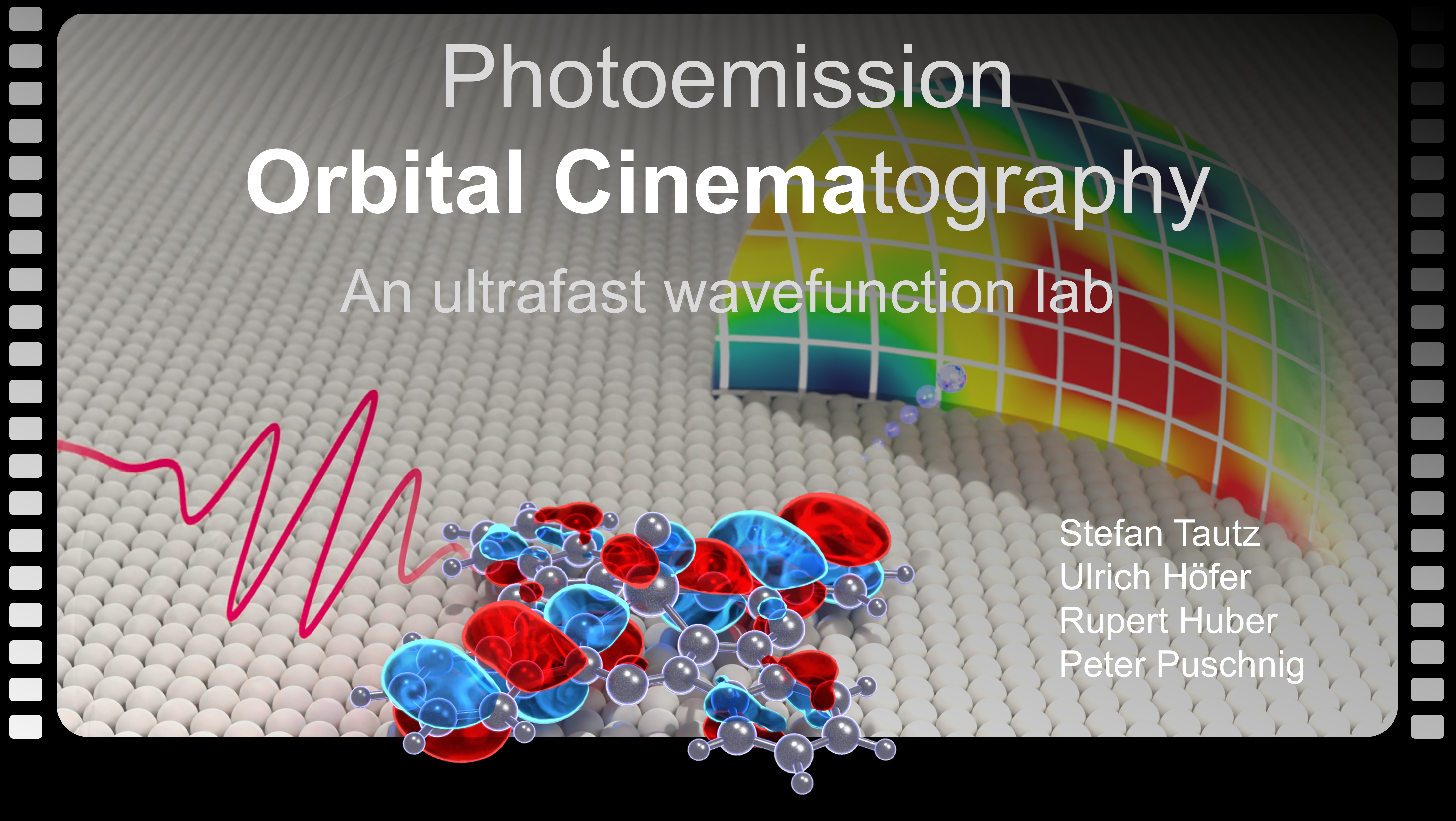
The new project is led jointly by Ulrich Höfer, Rupert Huber (Regensburg), Peter Puschnig (Graz), and Stefan Tautz (FZ Jülich, coordinator). It will involve Jens Güdde as an associated partner. The central goal of Orbital Cinema is to reach sub-cycle time resolution in orbital videography and to actively shape and functionalize molecular orbitals with lightwaves.
The foundation for this new research direction has been laid on the one hand by our collaboration with the Huber group in Regensburg, where we showed how surface and interface processes driven by strong electric fields can be investigated by angle-resolved photoemission spectroscopy with sub-cycle time resolution [J. Reimann et al., Nature 562, 396 (2018)]. Johannes Reimann was awarded the dissertation prize of Philipps University Marburg for this work. In the framework of SFB 1083, on the other hand, we successfully combined photoemission orbital tomography, invented in Graz, with laser-pump-probe techniques. In collaboration with the group of Stefan Tautz, we demonstrated that orbital images can be traced on ultrafast time scales in this way [R. Wallauer et al., Science 371, 1056 (2021)].
With its ERC Synergy Grants, the European Commission funds high risk projects with up to four PIs that target truly groundbreaking research, which cannot be tackled by an individual research team alone. Orbital Cinema has several very ambitious goals: On the picosecond timescale, it is to take movies on the orbital level of a chemical reaction from the initial state over transition states to the final product. On the femtosecond timescale, it is the ability to control charge transfer processes at interfaces, such as those underlying light harvesting. Finally, at the attosecond timescale, the ultimate goal is to resolve and sculpt what is presently called an instantaneous quantum leap. Most of the new experiments will be set up at the Regensburg Center for Ultrafast Nanoscopy (RUN).
Further Information
– Press releases of the European Research Council
– Press releases of the Forschungszentrum Jülich and the University of Regensburg (in German)
– Home page of SFB 1083 “Structure and Dynamics of Internal Interfaces”
September 2021
Ultrafast charge-transfer in twisted TMDC heterostructures
Zimmermann and coworkers time-resolve the formation of interlayer excitons in MoS2/WSe2 hetero-bilayers as function of twist angle
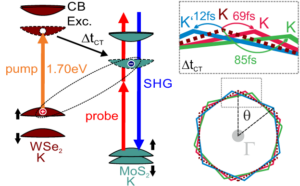
The pump-probe SHG measurements upon 1.70-eV photoexcitation reveal a strong stacking-dependence of the ultrafast electron transfer (ΔtCT) from WSe2 to MoS2.
Two-dimensional heterostructures of transition metal dichalcogenides (TMDC) represent very well-defined and at the same time highly versatile model systems of van der Waals interfaces. Many material combinations feature a type-II band alignment which can separate photoexcited electrons and holes into different layers leading to the formation of so-called interlayer or interface excitons. Gerson Mette and his team have employed second-harmonic imaging microscopy to investigate the ultrafast charge-carrier dynamics across MoS2/WSe2 heterostructure interfaces for different stacking configurations with a time resolution of 10 fs. The ultrafast electron transfer from WSe2 to MoS2 that occurs for an excitation energy of 1.7 eV is found to depend considerably on the stacking angle. The transfer time is reduced by a factor of seven when going from a larger rotational mismatch towards 2H-stacking. In contrast, hole transfer processes from MoS2 to hybridized states at the Γ-point and to the K-points of WSe2 that occur for higher excitation energies do not show a significant dependence on stacking angle. This indicates that radiative recombination of indirect Γ-K excitons becomes the dominant decay route under these conditions.
The work has been carried out in collaboration with the group of Tobias Korn in Rostock and the group of Christian Schüller in Regensburg and was funded by SFB 1083 „Structure and Dynamics of Internal Interfaces“.
Publication
J. E. Zimmermann, M. Axt, F. Mooshammer, P. Nagler, C. Schüller, T. Korn, U. Höfer, and G. Mette
„Ultrafast Charge-Transfer Dynamics in Twisted MoS2/WSe2 Heterostructures“
ACS Nano 15, 14725 (2021). DOI: 10.1021/acsnano.1c04549
June 2021
Formation dynamics of dark excitons in monolayer WS2
Robert Wallauer and coworkers observed how momentum-indirect dark excitons form on an ultrafast timescale.
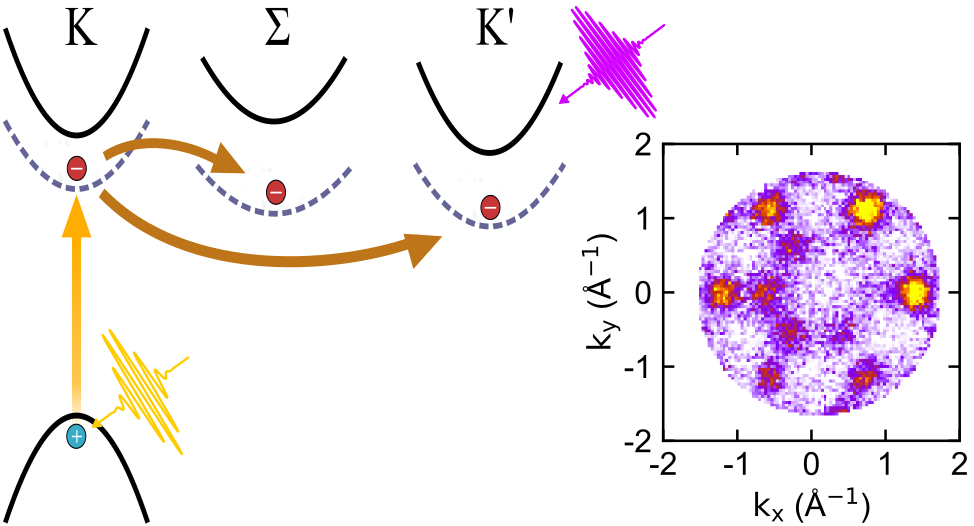
Excitons, which form out of electrons and holes at different locations of the Brillouin zone, so-called dark excitons, have been predicted and mainly investigated by theory, since they are not accessible by most experimental techniques.
Here, by using time-resolved momentum microscopy with a high-harmonic light source the exciton population was imaged in momentum-space. The formation of a dark KΣ exciton was observed in WS2 monolayer for the first time on its intrinsic time scale. In the first step a coherent polarisation is induced by the pump laser pulse in the K valley, which then decays to form bright and dark excitons. The experimental results were compared to a fully microscopic theory, which revealed the influence of the coherence in the formation process of the excitons.
The work has been carried out in collaboration with the group of Ermin Malic and the group of Rupert Huber in Regensburg and was funded by the collaborative research centre on „Structure and Dynamics of Internal Interfaces“ (SFB 1083).
Publication:
Robert Wallauer, Raul Perea-Causin, Lasse Münster, Sarah Zajusch, Samuel Brem, Jens Güdde, Katsumi Tanimura, Kai-Qiang Lin, Rupert Huber, Ermin Malic, and Ulrich Höfer
„Momentum-resolved observation of exciton formation dynamics in monolayer WS2“
Nano Letters 21, 5867 (2021). DOI: 10.1021/acs.nanolett.1c01839
May 2021
SFB 1083 extended by four more years
The German Research Foundation (Deutsche Forschungsgemeinschaft, DFG) has granted the Collaborative Research Centre SFB 1083 „Structure and Dynamics of Internal Interfaces“ 12.3 Million Euros for a third funding period from July 2021 to June 2025.
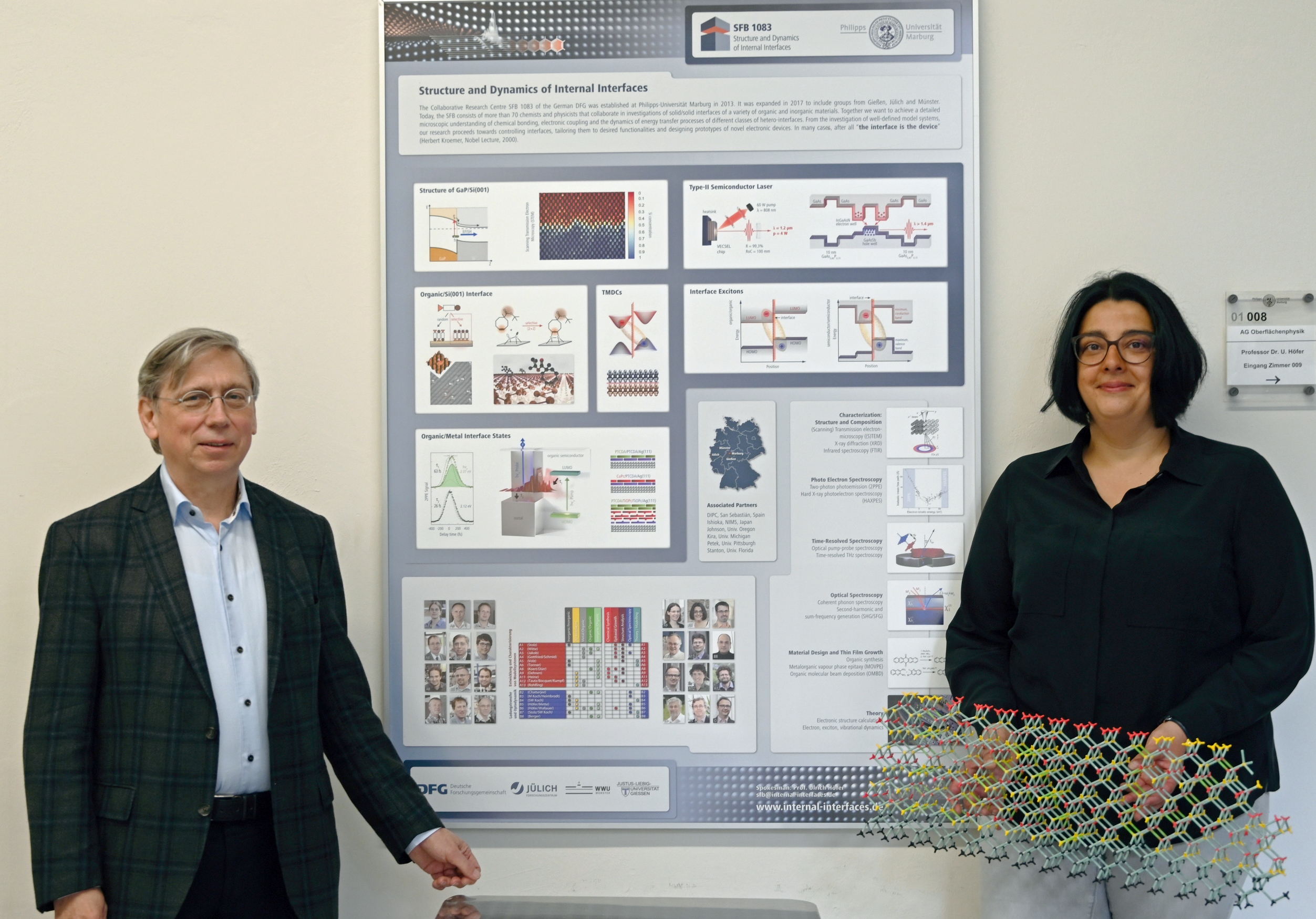
Present spokesman Ulrich Höfer (left) and future spokeswoman Kerstin Volz in front of a poster introducing SFB 1083, Foto: Stefan Kachel.
SFB 1083 was established at Philipps-Universität Marburg in 2013. It included a guest project from the Donostia International Physics Center in San Sebastián, Spain. Meanwhile, groups from the universities of Gießen, Leipzig, and Münster as well as the Forschungszentrum Jülich participate in the centre. From October 2013 to June 2021, Marburg and the participating institutions received DFG funding that amounts to 20.4 Million Euros. Together, the researchers have published more than 330 scientific papers. For a report on the scientific activities from 2013 to 2019, see the activity report. A video clip, also available in German, explains the relevance of research on internal interfaces to the general public and highlights selected contributions of SFB 1083. With the new grant, SFB 1083 will be supported for altogether 12 years, the maximum funding period for a DFG Collaborative Research Centre.
Further information:
News page SFB 1083
Press release of Marburg University (in German)
May 2021
Turning at top speed – novel light emission from topological surface states
A joint experiment with the group of Rupert Huber in Regensburg demonstrates efficient high-order harmonic generation at the surface of a topological insulator by driving ballistic electron currents at THz frequencies.
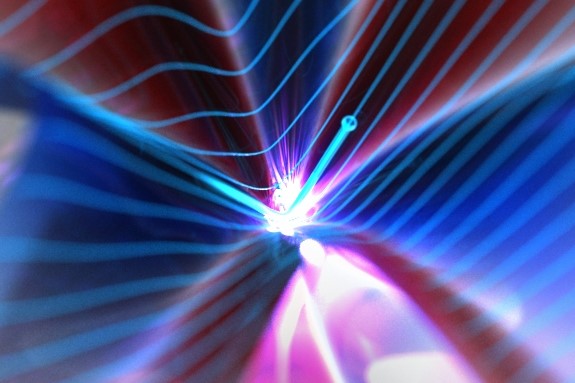
On the surface of a topological insulator (colored surface), electrons (small blue sphere) move with quasi-relativistic speed. When a strong light wave accelerates electrons through the so-called Dirac point (apex of the cone), their velocity abruptly flips. The instantaneous change of velocity leads to the emission of broadband electromagnetic radiation (flash in the middle of the colored surface).
In the conducting surface states of topological insulators electrons behave like massless particles, characterized by a linear dispersion (Dirac cone). Under the influence of an electric field, the electrons rapidly switch their direction of motion when their trajectories in momentum space come close to the minimum of the cone, the Dirac point. At frequencies in the range of 25 to 35 THz, this is the case for electric field strengths of several MV/cm. It results in the emission of an ultrafast flash of light containing a broadband spectrum that can be analyzed with optical detectors.
This novel mechanism of high-harmonic generation is only possible because the spin-momentum-locking in the Dirac cone prevents efficient electron scattering. The resulting long scattering times of ~ 1ps allow to drive strong ballistic electron currents as demonstrated with THz-ARPES previously (Reimann et al., Nature (2018)). The emitted high-harmonic radiation has a characteristic polarization dependence related to the Berry curvature of the Dirac cone. Moreover, it can be shifted to arbitrary non-integer multiples of the driving frequency by varying the carrier-envelope phase of the driving field. These specific properties set it apart from HHG processes in bulk semiconductors.
In the upcoming third funding period of SFB 1083, the new project B11 (Güdde/Höfer) will utilize THz high-harmonic radiation generated in this way and exploit its characteristic properties to investigate electron currents at interfaces of topological insulators buried under protecting capping layers. For future device applications it will be crucial to screen the unusual movement of Dirac electrons from the environment.
Further information:
Press release of Regensburg University
Pressemitteilung der Universität Marburg
Nachrichten des Fachbereichs Physik der Universität Marburg
Homepage of the Huber group in Regensburg
Publication:
C. P. Schmid, L. Weigl, P. Grössing, V. Junk, C. Gorini, S. Schlauderer, S. Ito, M. Meierhofer, N. Hofmann, D. Afanasiev, J. Crewse, K. A. Kokh, O. E. Tereshchenko, J. Güdde, F. Evers, J. Wilhelm, K. Richter, U. Höfer, and R. Huber, „Tuneable non-integer high-harmonic generation in a topological insulator“, Nature 593, 385 (2021). DOI: 10.1038/s41586-021-03466-7
February 2021
Tracing orbital images on ultrafast time scales
Robert Wallauer and coworkers image molecular orbitals during the ultrafast electron transfer process at interfaces
 The charge-transfer dynamics across molecular interfaces is reflected in the population of electronic orbitals. These were, for the first time, directly monitored with ultrafast time resolution by our group in collaboration with the group of Stefan Tautz in Jülich. The experiment excites the molecular LUMO of PTCDA/CuO/Cu(100) with ultrashort visible laser pulses and photoemits the electrons with a time delayed XUV pulse. The full two-dimensional intensity distribution of the photoemitted electrons is recorded with a time-of-flight momentum microscope developed by Robert Wallauer. Real space electron distributions and photoemission momentum maps, called orbital tomographs, are related by a Fourier transform (Photoemission Orbital Tomography, see Wikipedia).
The charge-transfer dynamics across molecular interfaces is reflected in the population of electronic orbitals. These were, for the first time, directly monitored with ultrafast time resolution by our group in collaboration with the group of Stefan Tautz in Jülich. The experiment excites the molecular LUMO of PTCDA/CuO/Cu(100) with ultrashort visible laser pulses and photoemits the electrons with a time delayed XUV pulse. The full two-dimensional intensity distribution of the photoemitted electrons is recorded with a time-of-flight momentum microscope developed by Robert Wallauer. Real space electron distributions and photoemission momentum maps, called orbital tomographs, are related by a Fourier transform (Photoemission Orbital Tomography, see Wikipedia).
The work has been funded by the collaborative research centre on „Structure and Dynamics of Internal Interfaces“ (SFB 1083).
Publication:
R. Wallauer, M. Raths, K. Stallberg, L. Münster, D. Brandstetter, X. Yang, J. Güdde, P. Puschnig, S. Soubatch, C. Kumpf, F. C. Bouquet, F. S. Tautz, U. Höfer,
„Tracing orbital images on ultrafast time scales“
Science 371, 1056 (2021): DOI: 10.1126/science.abf3286
March 2020
SFB 1083 image film portrays research at internal interfaces
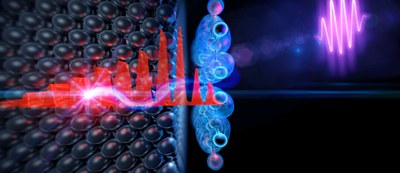
Still image of a computer animation from the SFB 1083 image film illustrating research of our group on metal/organic contacts and electronic interface states (Image: Till Schürmann)
Video
Struktur und Dynamik innerer Grenzflächen – YouTube (in German)
https://www.youtube.com/watch?v=9-kPE0hwNMM
Structure and Dynamics of Internal Interfaces – YouTube (in English)
https://www.youtube.com/watch?v=_mDt0NzHrc
Further Information (in German):
SFB 1083 news page
September 2019
New femtosecond laser system for time-resolved interface spectroscopy
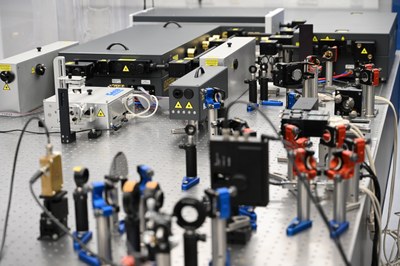
Differential reflectivity setup for coherent phonon spectroscopy in front of the new laser system, consisting of two optical parametric amplifiers (ORPHEUS-F-Twin and ORPHEUS-N-2H) pumped by a 40W-CARBIDE laser.
A new high-power laser system featuring three independently tuneable femtosecond laser pulses at repetition rates of 200 kHz has been setup recently.
June 2019
Johannes Reimann awarded dissertation prize of Philipps University Marburg
 Congratulations to Dr. Johannes Reimann, Bachelor, Master and Doctoral Student of our group, for being awarded a prize by Philipps University of Marburg for his excellent dissertation in 2018 (see Press Release Marburg University).
Congratulations to Dr. Johannes Reimann, Bachelor, Master and Doctoral Student of our group, for being awarded a prize by Philipps University of Marburg for his excellent dissertation in 2018 (see Press Release Marburg University).
In his thesis entitled „Charge carried dynamics and photocurrents in the Dirac cone of topological insulators“ Johannes Reimann investigated a novel class of materials, the topological insulators. These materials, discovered only a decade ago, are insulating in the volume but conductive at their surfaces and at their interfaces to conventional materials. In the framework of his thesis, Johannes Reimann advanced the development of time- and angle-resolved photoelectron spectroscopy of our group. In particular, his work is the first to combine this powerful technique with Terahertz excitation and to achieve subcycle time resolution. In collaboration with the group of Rupert Huber in Regensburg, he succeeded in taking band structure movies of electrical currents carried by Dirac electrons as they are driven by an intense THz wave. First results have been published in Nature in September 2018 (see News page SFB 1083, Joint Press Release of the Universities of Marburg and Regensburg (in German)).
The results of Johannes Reimann hold great promise to realize new lightwave-driven electronics, a concept to increase the clock rates of conventional semiconductor devices by a factor of 1000 and more. Moreover, the successful demonstration of the combination of intense THz pulses as pump and angle-resolved photoelectron spectroscopy (ARPES) as probe, has triggered worldwide experimental efforts to take advantage of THz-APRES for time-resolved investigation of a variety of solids, surfaces, and interfaces.
March 2019
Controlling a SN2 reaction by electronic and vibrational excitation: tip-induced ether cleavage on Si(001)
In a publication in Angewandte Chemie, Gerson Mette and coworkers used scanning tunneling microscopy for controlling the final products of a textbook-type reaction of organic molecules on silicon surfaces.

New final products are observed when ether cleavage on Si(001) is induced by the electrons of an STM tip. The nature of these final products can be controlled by the excitation mechanism.
Ether cleavage on silicon is the surface analogue of an SN2 reaction; SN2 reactions represent the textbook example for how to control solution-based chemical reactions by means of steric hinderance or the choice of solvent. In their study, the team around Gerson Mette and Michael Dürr has now shown that tip-induced ether cleavage on Si(001) leads to additional final products which are not obtained by thermal activation. Moreover, different final products can be selectively addressed by different excitation channels, either direct excitation by electron transfer or multiple excitation of vibrational modes. As the two channels can be selectively addressed by the tunneling bias, a new way of reaction control was achieved. In particular, in combination with on-surface reactions of organic building blocks, this could lead to molecular architectures beyond the limitations of thermal activation.
The work has been funded by the DFG through the collaborative research centre on „Structure and Dynamics of Internal Interfaces“ (SFB 1083), the Research Training Group „Functionalization of Semiconductors“ (GRK 1782), and project DU 1157/4-1.
September 2018
Lightwave-driven Dirac currents in a topological surface band
Johannes Reimann, Jens Güdde and Ulrich Höfer together with a team led by Rupert Huber in Regensburg and collaborators in Novosibirsk and Hiroshima have taken band structure movies of electrical currents as they are driven by an intense THz wave.

Artistic view of the experiment. The electric field of an intense terahertz light pulse accelerates electrons (green stripes) at the surface of a toplogical insulator at optical clock rates. The displacement of the Dirac electrons in the hourglass-shaped band structure is tracked by time- and angle-resolved photoemission with subcycle time resolution.
The currents are carried by Dirac electrons at the surface of the topological insulator Bi2Te3. The research merges two novel and promising concepts in physics – topology and lightwave electronics. It combines the expertise of the Regensburg group to manipulate electrons in solids by intense terahertz (THz) pulses, with the capabilities of time and angle-resolved photoelectron spectroscopy (ARPES) developed in Marburg.
The work has been funded by the DFG through its priority program „Topological Insulators“ (SPP 1666) and the collaborative research centre on „Structure and Dynamics of Internal Interfaces“ (SFB 1083).
November 2017
Alexander Lerch receives ACS Nano poster-prize at ESPMI9 in Singapore
Alexander Lerch was awarded an „ACS Nano Poster Prize“ at the 9th edition of the international workshop on Electronic Structure and Processes at Molecular-Based Interfaces (ESPMI9) in Singapore.
 In his contribution, Alexander Lerch presented new insights into carrier dynamics at metal-molecule interfaces investigated by means of time resolved two-photon photoemission (2PPE). The experimental results obtained in model systems consisting of well-defined molecular layers deposited on single crystaline metal substrates highlight the capability of interface-related electronic states to mediate charge transfer. Poster „Interface-specific mechanisms of charge transfer at metal-molecule contacts“
In his contribution, Alexander Lerch presented new insights into carrier dynamics at metal-molecule interfaces investigated by means of time resolved two-photon photoemission (2PPE). The experimental results obtained in model systems consisting of well-defined molecular layers deposited on single crystaline metal substrates highlight the capability of interface-related electronic states to mediate charge transfer. Poster „Interface-specific mechanisms of charge transfer at metal-molecule contacts“November 2017
Klaus Stallberg is awarded dissertation-prize at TU Clausthal
Congratulations to Dr. Klaus Stallberg, who recently joined our group as a postdoc, for being awarded a dissertation-prize by the TU Clausthal.
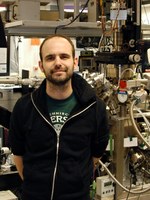 In his thesis entitled „Spectromicroscopic investigations of thin porphyrin layers and their influence on plasmonic excitations in silver structures by multi-photon-photoemission“ Klaus Stallberg investigated thin porphyrin films and plasmonic silver structures with multi-photon photoemission electronmicroscopy (nP-PEEM). Based on energy-resolved, time-resolved and laterally resolved nPPE experiments he porposed a model for the complex electronic excitation and relaxation processes in porphyrin films and was able to show how a thin porphyrin layer affects the dispersion of plasmons propagating on an extended silver island.
In his thesis entitled „Spectromicroscopic investigations of thin porphyrin layers and their influence on plasmonic excitations in silver structures by multi-photon-photoemission“ Klaus Stallberg investigated thin porphyrin films and plasmonic silver structures with multi-photon photoemission electronmicroscopy (nP-PEEM). Based on energy-resolved, time-resolved and laterally resolved nPPE experiments he porposed a model for the complex electronic excitation and relaxation processes in porphyrin films and was able to show how a thin porphyrin layer affects the dispersion of plasmons propagating on an extended silver island.
Since July 2017 Klaus Stallberg explores the dynamics of charge transfer processes at interfaces of organic heterostructures by means of time-resolved two-photon photoemission in the surface physics group.
July 2017
Poster Presentation Prize at ICFSI-16 in Hannover
Johannes Reimann was awarded a „Poster Prize“ for his presentation at the 16th International Conference on the Formation of Semiconductor Interfaces (ICFSI-16) in Hannover.
 In his contribution, Johannes Reimann reported about the generation and control of spin polarized photocurrents in the Dirac Cone of the topological insulator Sb2Te3 by means of time and angle resolved two-photon photoemission (2PPE). The experimental results allow for a better understanding of the fundamental processes governing the electron dynamics inside the topological surface states of this material class.
In his contribution, Johannes Reimann reported about the generation and control of spin polarized photocurrents in the Dirac Cone of the topological insulator Sb2Te3 by means of time and angle resolved two-photon photoemission (2PPE). The experimental results allow for a better understanding of the fundamental processes governing the electron dynamics inside the topological surface states of this material class.
The research is part of the DFG priority program „Topological Insulators: Materials-Fundamental Properties-Devices“ (SPP 1666).
ICFSI-16, July 2-7, 2017, Hannover – is part of a biannual conference series primarily focused on phenomena at surfaces, interfaces, and nanostructures that are of strong current interest, ranging from characterization at the atomic scale to prospects of applications.
Poster „Optical control of ultrafast currents in the topological surface state of Sb2Te3“ by J. Reimann, K. Kuroda, K. A. Kokh, O. E. Tereshchenko, A. Kimura, J. Güdde, and U. Höfer (Philipps-Universität Marburg) – Germany.
May 2017
SFB 1083 „Internal Interfaces“ extended by 4 years
Additional 10.5 Million Euros for Marburg’s Physicists and Chemists

Prof. Dr. Ulrich Höfer of the Department of Physics at Philipps-Universität Marburg is spokesman for the DFG’s Collaborative Research Center (SFB) 1083 „Structure and Dynamics of Internal Interfaces“. Photo: Philipps-Universität Marburg, Rolf K. Wegst.
The German Research Foundation (Deutsche Forschungsgemeinschaft DFG) has granted Marburgs Collaborative Research Center (Sonderforschungsbereich) SFB 1083 „Structure and Dynamics of Internal Interfaces“ 10.5 Million Euros funding over the course of another four years until 2021. With this, the SFB – under guidance of its spokesman physicist Prof. Dr. Ulrich Höfer – will enter a new phase. The initial four years focussed on understanding the physical-chemical phenomena at interfaces, while the new focal point will be on controlling these phenomena and tailoring them for application.
Cooperation with partners in Jülich, Münster and Gießen
The new funding period will bring together 60 to 80 scientists in 18 research projects. One of these is located at the university in Münster (A13), one at the Peter-Grünberg-Institut in Jülich (A12), and two are located at the university in Gießen. Six projects are led by young research staff that has not yet attained a professorship.
New challenges: stacking of material layers and mixing of characteristics
In the new funding period SFB 1083 will also include research into novel two-dimensional materials. These single-atom-thick layers basically consist of „surface“ only. In transfering newly gained insights into internal interfaces, SFB 1083’s researchers will build heterosystems with new effects by stacking layers of mixing characteristics of 2D-materials. By controlling these processes the scientists expect to offer the material sciences a modular assemblage box. A new collaboration with a research center at Columbia University New York is part of this strategy.
See the full press release in German for detail.
November 2016
Interface between Silicon Technology and Organic Chemistry
Chemists and physicists of SFB 1083 (M. Dürr, U. Koert and U. Höfer) demonstrate for the first time the controlled chemoselective attachment of bifunctional organic molecules to silicon.

Interface between semiconductor technology and organic chemistry: cyclooctyne selectively attaches to the Si-surface allowing additional functional groups to remain free (image: Marcel Reutzel & Michael Dürr; image may be used in reporting on the publication in JPCC only).
With these results, which were highlighted on the cover page of The Journal of Physical Chemistry, an interface between silicon and organic multilayers has been created [1]. This interface opens the road for a controlled functionalization of silicon with organic molecules. In this way, it offers new perspectives in semiconductor technology („More than Moore“).
Chemoselective attachment of multifunctional organic molecules is the first fundamental process step for the controlled organic functionalization of semiconductor surfaces. However, the high reactivity of pristine silicon surfaces, especially of the technologically most relevant Si(001) surface, has prohibited so far such a controlled functionalization: multifunctional molecules do not show chemical selectivity on these surfaces but are found with different functional groups attached.
In a joint effort, chemists and physicists of the SFB 1083 „Structure and Dynamics of Internal Interfaces“ developed for the first time a general strategy for solving this problem: Using substituted cyclooctynes, they obtained well-defined inorganic-organic interfaces on Si(001) with the bifunctional molecules attached to the silicon surface solely via a cyclooctyne’s strained triple bond. The second functionality is thus available for further building up of complex molecular architectures, e.g., using organic click chemistry. The strategy for the observed chemoselectivity is based on the distinctly different adsorption dynamics of the separate functional groups and thus widely applicable.
In combination with the results for controlled multilayer synthesis in solution using the same classes of molecules [2], this work is a promising basis for a multitude of applications combining semiconductor technology and organic chemistry, e.g., the integration of optically active organic layers on silicon devices. The obtained structures are also of high interest for further studies of the electronic properties at organic/semiconductor interfaces within SFB 1083.
Publication:
[1] M. Reutzel, N. Münster, M. A. Lipponer, C. Länger, U. Höfer, U. Koert, M. Dürr, Chemoselective Reactivity of Bifunctional Cyclooctynes on Si(001),
J. Phys. Chem. C 120, 26284 (2016), DOI: 10.1021/acs.jpcc.6b07501.
See also press release in German.
October 2016
Momentum space mapping of electron transfer processes in MoS2
In a publication in Applied Physics Letters Robert Wallauer and coworkers report on a new experimental setup for time-resolved two-phonon photoemission (2PPE). The method, which combines femtosecond pump-probe techniques with photoelectron spectroscopy, makes it possible to map the dynamics of electron transfer processes at surfaces and interfaces directly in momentum space.
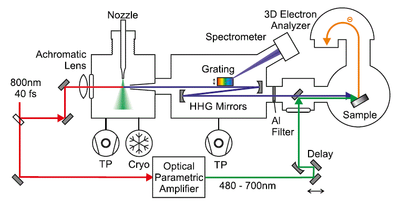
Sketch of the experimental setup. Pump pulses are frequency converted by an optical parametrical amplifier. Probe pulses are focused into a Xe-jet and the generated harmonics are selected by two multi-layer mirrors. Both pulses are overlapped before entering the analyzer chamber equipped with a Scienta DA30 hemispherical analyzer. (published Fig. 1)
Sketch of the experimental setup. Pump pulses are frequency converted by an optical parametrical amplifier. Probe pulses are focused into a Xe-jet and the generated harmonics are selected by two multi-layer mirrors. Both pulses are overlapped before entering the analyzer chamber equipped with a Scienta DA30 hemispherical analyzer. (published Fig. 1)
The new experiment combines a high-harmonic generation (HHG) light source, developed and built in Marburg, with a state-of-the-art 3D hemispherical electron analyzer (VG Scienta DA30). The analyzer can measure electron energies as a function of both parallel momentum directions (kx and ky)) without movement of the sample. The high-harmonic source gives access to the full 2D Brillouin zone whereas conventional 2PPE setups are restricted to electrons near the 𝛤 point.
The large parallel momenta, which become accessible with the new experiment, enable SFB 1083 to study electron dynamics at interfaces of many interesting new materials. Particularly, in the class of two-dimensional transition-metal dichalcogenides (TMDCs), most of the interesting electron dynamics take place at the boundary of the first Brillouin zone. Investigations of the intervalley scattering in the topmost layer of MoS2, a prototypical TMDC, demonstrate this capability. Electrons excited at the K-point are found to scatter to the Σ-point in less than 50 fs by directly mapping the electron population in k-space as a function of time.
The new experiment opens up the possibility to study charge transfer and exciton formation with 2PPE in a variety of systems, most prominently van-der-Waals heterostructures, which are a combination of different single-layer TMDCs. In these systems, upon excitation, charge transfer excitons can form. Their formation and relaxation pathways can now be examined by a direct mapping technique in momentum space.
June 2016
Spectroscopy and dynamics of a two-dimensional electron gas on ultrathin helium films on Cu(111)
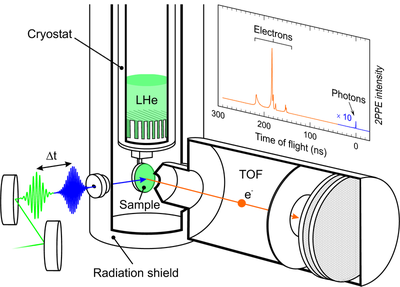 Electrons in image-potential states on the surface of bulk helium represent a unique model system of a two-dimensional electron gas of varying density. For electrons on bulk He, however, the maximum density is restricted to ~2×109 e–/cm2 due to ripplon formation and the electron gas remains in the classical regime. Early, It was realized that the electron density can be significantly increased by growing He films on a substrate with large permittivity like a metal. This offers the possibility to study the quantum regime of this almost ideal 2D electron system including effects such as Wigner crystalization and quantum melting. For very thin films, however, the coupling to the substrate will be strongly influenced by the surface quality. The study of this regime therefore requires the combination of state-of-the-art surface science and advanced cryo techniques.
Electrons in image-potential states on the surface of bulk helium represent a unique model system of a two-dimensional electron gas of varying density. For electrons on bulk He, however, the maximum density is restricted to ~2×109 e–/cm2 due to ripplon formation and the electron gas remains in the classical regime. Early, It was realized that the electron density can be significantly increased by growing He films on a substrate with large permittivity like a metal. This offers the possibility to study the quantum regime of this almost ideal 2D electron system including effects such as Wigner crystalization and quantum melting. For very thin films, however, the coupling to the substrate will be strongly influenced by the surface quality. The study of this regime therefore requires the combination of state-of-the-art surface science and advanced cryo techniques.
In collaboration with Peter Feulner from the TU Munich, we investigate the properties of image-potential states on He in the extreme case of reduced film thickness: a monolayer of helium physisorbed on a single-crystalline Cu surface. For this purpose we have utilized a customized setup for time-resolved two-photon photoemission (2PPE) at very low temperatures under ultra-high vacuum conditions. We demonstrate that the highly polarizable metal substrate increases the binding energy of the first (n=1) image-potential state by more than two orders of magnitude as compared to the surface of liquid helium. An electron in this state is still strongly decoupled from the metal surface due to the large negative electron affinity of helium and we find that even one monolayer of helium increases its lifetime by one order of magnitude compared to the bare Cu(111) surface.
In a further optimized setup, which reaches temperatures below 1 K as required for the growth of thicker He layers, our results let us expect to realize lifetimes of several hundred picoseconds even on an only 2-ML-thick He film on Cu(100) or Ag(100). The binding energy on such thin film is still large enough to support high electron densities without becoming instable due to ripplon formation. In combination with angle-resolved photoemission spectroscopy, this opens the possibility to observe phenomena such as Wigner crystallization and melting into a degenerate 2D electron gas within momentum space.
N. Armbrust, J. Güdde, U. Höfer, S. Kossler, and P. Feulner, Phys. Rev. Lett. 116, 256801 (2016).
February 2016
Generation of transient photocurrents in the topological surface state of Sb2Te3 by direct optical excitation with mid-infrared pulses
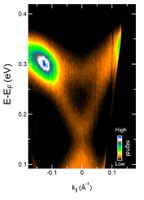 We combine tunable midinfrared (mid-IR) pump pulses with time- and angle-resolved two-photon photoemission to study ultrafast photoexcitation of the topological surface state (TSS) of Sb2Te3. It is revealed that mid-IR pulses permit a direct excitation from the occupied to the unoccupied part of the TSS across the Dirac point. The novel optical coupling induces asymmetric transient populations of the TSS at ±k∥, which reflects a macroscopic photoexcited electric surface current. By observing the decay of the asymmetric population, we directly investigate the dynamics of the long-lived photocurrent in the time domain. Our discovery promises important advantages of photoexcitation by mid-IR pulses for spintronic applications.
We combine tunable midinfrared (mid-IR) pump pulses with time- and angle-resolved two-photon photoemission to study ultrafast photoexcitation of the topological surface state (TSS) of Sb2Te3. It is revealed that mid-IR pulses permit a direct excitation from the occupied to the unoccupied part of the TSS across the Dirac point. The novel optical coupling induces asymmetric transient populations of the TSS at ±k∥, which reflects a macroscopic photoexcited electric surface current. By observing the decay of the asymmetric population, we directly investigate the dynamics of the long-lived photocurrent in the time domain. Our discovery promises important advantages of photoexcitation by mid-IR pulses for spintronic applications.
K. Kuroda, J. Reimann, J. Güdde, and U. Höfer, Phys. Rev. Lett. 116, 076801 (2016).
June 2015
Best Poster Award at USD9 in Japan
Alexander Lerch was honored with a „Best Presentation Award for Young Scientists“ at the 9th International Symposium on Ultrafast Surface Dynamics (USD9) at Lake Biwa, Japan.
 In his poster presentation Alexander Lerch presented new insights into carrier dynamics at the buried GaP/Si(001) interface achieved by means of time-resolved second-harmonic generation and contributes to a better understanding of the fundamental aspects of carrier dynamics at structurally well characterized solid/solid interfaces. The research is part of SFB 1083 „Structure and Dynamics of Internal Interfaces“ and undertaken in close collaboration with the groups of Wolfgang Stolz and Kerstin Volz.
In his poster presentation Alexander Lerch presented new insights into carrier dynamics at the buried GaP/Si(001) interface achieved by means of time-resolved second-harmonic generation and contributes to a better understanding of the fundamental aspects of carrier dynamics at structurally well characterized solid/solid interfaces. The research is part of SFB 1083 „Structure and Dynamics of Internal Interfaces“ and undertaken in close collaboration with the groups of Wolfgang Stolz and Kerstin Volz.
USD9 was the 9th symposium in a series of biannual meetings in the field of femtosecond dynamics at surfaces and interfaces which has become the foremost international discussion forum to outline and trigger present and future research in that field.
Poster „Time-resolved nonlinear spectroscopy at the buried GaP/Si interface“ by A. Lerch, K. Brixius, A. Beyer, K. Volz, W. Stolz, and U. Höfer (Philipps-Universität Marburg) – The 9th International Symposium on Ultrafast Surface Dynamics (USD9) May 25-29, 2015, Lake Biwa, Japan
October 2013
Neuer DFG-Schwerpunkt „Topologische Isolatoren“
Am 8. Oktober 2013 fand in Frankfurt das Kickoff meeting des DFG-Schwerpunkts „Topological Insulators: Materials – Fundamental Properties – Devices“ (SPP 1666) statt. Die Marburger Oberflächenphysik (Prof. Dr. Ulrich Höfer) ist eine von 35 Gruppen in Deutschland, die an diesem neu eingerichteten Forschungsschwerpunkt beteiligt ist.
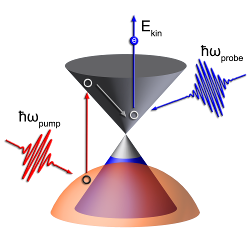 Die neue Materialklasse der topologischen Isolatoren wurde erst kürzlich entdeckt. Topologische Isolatoren sind nur in ihrem Inneren Isolatoren. An ihrer Oberfläche weisen sie topologisch geschützte Zustände auf, die ihnen dort zu elektrischer Leitfähigkeit verhelfen. Diese Oberflächenzustände zeichnen sich durch eine Reihe von bemerkenswerten Eigenschaften aus. Eine davon ist der richtungsabhängige Spinzustand, welcher die Streuung der Elektronen stark behindert.
Die neue Materialklasse der topologischen Isolatoren wurde erst kürzlich entdeckt. Topologische Isolatoren sind nur in ihrem Inneren Isolatoren. An ihrer Oberfläche weisen sie topologisch geschützte Zustände auf, die ihnen dort zu elektrischer Leitfähigkeit verhelfen. Diese Oberflächenzustände zeichnen sich durch eine Reihe von bemerkenswerten Eigenschaften aus. Eine davon ist der richtungsabhängige Spinzustand, welcher die Streuung der Elektronen stark behindert.
Eine andere auffallende Eigenschaft ist die lineare Dispersion der Zustände, deren Struktur deshalb als Dirac Cone bezeichnet wird. Unter linearer Dispersion versteht man die Eigenschaft, dass die Energie der Elektronen nicht quadratisch von ihrer Geschwindigkeit abhängt, sondern linear mit ihr zunimmt, wie dies sonst für relativistische Elektronen charakteristisch ist, welche durch die Dirac-Gleichung beschrieben werden. In topologischen Isolatoren, wie auch in Graphen, ist die Ursache für die lineare Dispersion aber nicht die hohe Geschwindigkeit, mit der sich die Elektronen parallel zur Oberfläche bewegen, sondern die speziellen Bindungsverhältnisse an der Oberfläche.
Die Arbeitsgruppe Oberflächenphysik wird im Rahmen dieses Schwerpunkts grundlegende Untersuchungen zur Ladungsträgerdynamik in den topologisch geschützten Zuständen durchführen. Die dabei verwendete Technik der zeit- und winkelaufgelösten Zwei-Photonen-Photoemission (2PPE) verwendet ultrakurze Laserimpulse, um die Energie- und Impulsverteilung optisch angeregter Elektronen mit hoher Zeitauflösung zu verfolgen.
Weitere Informationen:
Prof. Dr. Ulrich Höfer,
Arbeitsgruppe Oberflächenphysik
Tel.: 06421 28-24215, -24216 (Sekretariat)
E-Mail: Hoefer@physik.uni-marburg.de
May 2013
Research at Interfaces
In a new collaborative research centre, physicists and chemists from Marburg are investigating the “structure and dynamics of internal interfaces”. This is the title of a “Sonderforschungsbereich” (SFB), whose installation has just been decided by the “Deutsche Forschungsgemeinschaft” (DFG). The physicist Professor Dr. Ulrich Höfer from the Philipps-Universität is the initiator and spokesman of the consortium, which will be supported by the DFG with 8.7 million Euros during the following four years.

SFB coordinator, Professor Dr. Ulrich Höfer (right), inspects an experimental setup for laser spectroscopy of silicon interfaces together with his deputy, Professor Dr. Kerstin Volz, and the vice president of the university, Professor Dr. Ulrich Koert. „As the vice president for research I am happy about the success of Marburg’s natural sciences, as a participating chemist I am happy about the possibility to continue the successful cooperation with the physicists“, says Koert on the occasion of the DFG decision. (photograph: press office Philipps-Universität / Markus Farnung)
“With this funding decision the work of our researchers over many years receives its well-deserved acknowledgement”, says Professor Dr. Katharina Krause, president of the Philipps-Universität. “The university administration is extremely pleased, that the investments into materials sciences and semiconductor physics pay off in this way and we thank the involved scientists for their outstanding commitment.”
Interfaces are contact areas between different materials. They play a decisive role in miniaturized semiconductors, which are used, for example in electronic circuits. These semiconductors are constructed of several layers of different elements, similar to a sandwich cake. “The interfaces between the different materials frequently determine which optical and electronic characteristics such semiconductor devices possess”, explains Höfer.
The importance of internal interfaces will continue to increase further, when future hybrid materials combine the characteristics of metals, traditional inorganic semiconductors and organic materials”, predicts Höfer. Examples of such hybrid materials are novel solar cells and biosensors. “Our microscopic understanding of the structure and dynamics of internal interfaces, however, is lagging far behind their enormous importance.” The main cause of this knowledge gap is the experimental difficulty to detect the weak signals of the interface, which is often buried under many layers of other materials.
The initiators of the new CRC aim to close this gap by the collaboration between different research areas such as semiconductor physics, surface science, chemical synthesis, structural analysis and laser spectroscopy. For these efforts the University of Marburg offers a perfect environment because, according to the DFG referees, the combined expertise in these research areas is worldwide unique at this location. The list of the participating scientists includes 15 groups of the Faculties of Physics and Chemistry, of the Materials Sciences Center, and of a guest project of the Basque institution “Donostia International Physics Center”, in San Sebastián, Spain.
Initially, the investigations will not be directed towards specific functional materials as those generally consist of many, frequently not well defined interfaces. Instead, the focus will be on model systems with specially prepared internal interfaces. These interfaces will be structurally characterized on the atomic level and their optical and electronic properties will be systematically investigated.
In this way, a detailed microscopic understanding and prediction of chemical bonding, electronic coupling and energy transfer for different classes of heterointerfaces shall be achieved. “In the medium and long term this knowledge shall be used in order to tailor interfaces for new applications and construct devices with novel properties and functions”, explaines Höfer.
April 2012
High-order harmonic generation with µJ laser pulses at high repetition rates
 We investigate the generation of high-order harmonics using laser pulse energies in the few-µJ range at high repetition rates. We analyse how the conversion efficiency is influenced by the tight focusing geometry required for the generation of high-order harmonics under these conditions. A generalized phase-matching model allows us to discuss macroscopic phase effects independent of focal length. We present experimental results using the example of a 100 kHz laser system to generate harmonics up to the 27th order in Ar with a photon flux up to 3 x 109 photons s-1 into one harmonic order. High-repetition-rate femtosecond or even attosecond light sources open new possibilities for a broad range of applications such as time-resolved photoelectron spectroscopy and microscopy in the extreme ultraviolet regime.
We investigate the generation of high-order harmonics using laser pulse energies in the few-µJ range at high repetition rates. We analyse how the conversion efficiency is influenced by the tight focusing geometry required for the generation of high-order harmonics under these conditions. A generalized phase-matching model allows us to discuss macroscopic phase effects independent of focal length. We present experimental results using the example of a 100 kHz laser system to generate harmonics up to the 27th order in Ar with a photon flux up to 3 x 109 photons s-1 into one harmonic order. High-repetition-rate femtosecond or even attosecond light sources open new possibilities for a broad range of applications such as time-resolved photoelectron spectroscopy and microscopy in the extreme ultraviolet regime.
C. M. Heyl, J. Güdde, A. L’Hullier, and U. Höfer, J. Phys. B: At. Mol. Opt. Phys. 45, 074020 (2012).
Selected by Journal of Physics B as Highlight 2012
see also: Labtalk „Scaling up the repetion rate of high-order harmonic sources“
February 2012
Time-Resolved Two-Photon Photoemission of Unoccupied Electronic States of Periodically Rippled Graphene on Ru(0001)
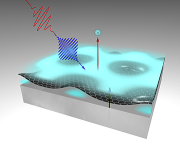 The unoccupied electronic states of epitaxially grown graphene on Ru(0001) have been explored by time- and angle-resolved two-photon photoemission (2PPE). We identify a Ru derived resonance and a Ru/graphene interface state at 0.91 eV and 2.58 eV above the Fermi level, as well as three image-potential derived states close to the vacuum level. The most strongly bound, short lived and least dispersing image-potential state is suggested to have some quantum-well character with a large amplitude below the graphene hills. The two other image-potential states are attributed to a series of slightly decoupled states. Their lifetimes and dispersions are indicative of electrons moving almost freely above the valley areas of the moiré superstructure of graphene.
The unoccupied electronic states of epitaxially grown graphene on Ru(0001) have been explored by time- and angle-resolved two-photon photoemission (2PPE). We identify a Ru derived resonance and a Ru/graphene interface state at 0.91 eV and 2.58 eV above the Fermi level, as well as three image-potential derived states close to the vacuum level. The most strongly bound, short lived and least dispersing image-potential state is suggested to have some quantum-well character with a large amplitude below the graphene hills. The two other image-potential states are attributed to a series of slightly decoupled states. Their lifetimes and dispersions are indicative of electrons moving almost freely above the valley areas of the moiré superstructure of graphene.
N. Armbrust, J. Güdde, P. Jakob, and U. Höfer, Phys. Rev. Lett. 108, 056801 (2012).
December 2011
PRL Editors‘ Suggestions: Trapping of image-potential resonances on free-electron-like metal surface
 Image-potential states have been studied by two-photon photoemission (2PPE) for the surface of Al(100) where the whole series is energetically degenerate with free-electron-like bulk states. In contrast to expectations, the series of resonances is not smeared out to one broad structure as a result of a strong coupling to the bulk continuum. Instead, the first resonance (n=1) is found to be suppressed and the resonances with quantum numbers n=2,3,4,5 are resolved as individual peaks in the time-resolved spectra. Both effects are suggested to be a consequence of resonance trapping.
Image-potential states have been studied by two-photon photoemission (2PPE) for the surface of Al(100) where the whole series is energetically degenerate with free-electron-like bulk states. In contrast to expectations, the series of resonances is not smeared out to one broad structure as a result of a strong coupling to the bulk continuum. Instead, the first resonance (n=1) is found to be suppressed and the resonances with quantum numbers n=2,3,4,5 are resolved as individual peaks in the time-resolved spectra. Both effects are suggested to be a consequence of resonance trapping.M. Winter, E. V. Chulkov, and U. Höfer, Phys. Rev. Lett. 107, 236801 (2011).
September 2009
Christian Schwalb erhält den ECOSS-Prize
 Dr. Christian Schwalb, wissenschaftlicher Mitarbeiter am Fachbereich Physik, wurde auf der 26th European Conference on Surface Science (ECOSS) in Parma, Italien für seine Forschungsarbeiten zur Dynamik des Ladungstransfers an organischen Grenzflächen mit dem ECOSS-Preis 2009 ausgezeichnet.
Dr. Christian Schwalb, wissenschaftlicher Mitarbeiter am Fachbereich Physik, wurde auf der 26th European Conference on Surface Science (ECOSS) in Parma, Italien für seine Forschungsarbeiten zur Dynamik des Ladungstransfers an organischen Grenzflächen mit dem ECOSS-Preis 2009 ausgezeichnet.
Mit über 700 Teilnehmern ist die European Conference on Surface Science (ECOSS) eine der weltweit größten internationalen Fachtagungen auf dem Gebiet der Oberflächen- und Grenzflächenforschung. Mit dem mit 1500 € dotierte ECOSS-Preis wird jährlich der beste Beitrag eines Doktoranden oder jüngeren Postdoktoranden ausgezeichnet.
Dr. Schwalb hat in Marburg Physik studiert und, nach der Rückkehr von einem einjährigen Auslandsaufenthalt an der Universität von Arizona in Tucson (USA), in der Gruppe von Prof. Dr. Ulrich Höfer mit Untersuchungen von Diffusionsvorgängen von atomarem Wasserstoff auf Silizium im Jahr 2004 diplomiert. Seine im Jahr 2008 abgeschlossene Doktorarbeit führte er ebenfalls in der Gruppe Höfer durch, wandte sich aber einer neuen Fragestellung zu, nämlich der des Ladungstransfers an der Grenzfläche von Metallen und dünnen organischen Schichten, die er insbesondere mit der Methode der zeitaufgelösten Zweiphotonen Photoemission (2PPE) experimentell untersuchte. Diese Arbeit wurde jetzt mit dem ECOSS-Preis ausgezeichnet. Seit Anfang 2009 ist Dr. Schwalb wissenschaftlicher Mitarbeiter in der Arbeitsgruppe molekulare Festkörperphysik von Prof. Dr. Gregor Witte.
Der Ladungsträgertransport an organischen Grenzflächen ist von großer Bedeutung für die Effizienz vieler neuartiger Bauelemente, die auf organischen Materialien basieren, wie z. B. organische Leuchtdioden oder Solarzellen. Das fundamentale Verständnis dieser Prozesse steckt allerdings noch ganz in den Anfängen und ist beispielsweise deutlich geringer als bei den konventionellen Halbleiterbauelementen. In enger Zusammenarbeit mit der Arbeitsgruppe von Prof. Dr. Eberhard Umbach und Prof. Dr. Friedel Reinert von der Universität Würzburg hat Dr. Schwalb das System PTCDA/Ag(111) untersucht, welches ein Modellsystem für eine Metall/Organik-Grenzfläche darstellt. Sein Hauptergebnis war dabei die Entdeckung und Charakterisierung eines spezifischen elektronischen Zustands, der sich an der Grenzfläche durch die Wechselwirkung des organischen Films mit dem Metall ausbildet. Die Resultate die im Sommer 2008 in der Zeitschrift Phys. Rev. Lett. (Link) publiziert wurden, stellen einen Durchbruch bei der Untersuchung des Ladungsträgertransports an Metall/Organik-Grenzflächen dar, da es mit Hilfe der zeitaufgelösten 2PPE zum ersten Mal gelungen ist, die ultraschnelle Elektronendynamik an einer solchen Grenzfläche direkt in der Zeitdomäne experimentell zu untersuchen.
November 2007
Generation and investigation of ultrashort electrical currents
 Using modern optical techniques, researchers from the Department of Physics of the Philipps-University of Marburg succeeded in generating and investigating electrical current pulses which are more than thousand times shortes as can be measured by the fastest available electronics. These ultrashort current pulses were generated by irradiation of metal surfaces with femtosecond laser pulses (1 femtosecond = 1 fs = 0.000 000 000 000 001 seconds) Due to their short duration these current pulses make it possible to study fundamental mechanisms of the interaction of electrons in solids. In particular, it was for the first time possible to observe the ultrafast temporal evolution of microscopical processes that are responsible for the electrical resistance of solids (SCIENCE, November 23, 2007).
Using modern optical techniques, researchers from the Department of Physics of the Philipps-University of Marburg succeeded in generating and investigating electrical current pulses which are more than thousand times shortes as can be measured by the fastest available electronics. These ultrashort current pulses were generated by irradiation of metal surfaces with femtosecond laser pulses (1 femtosecond = 1 fs = 0.000 000 000 000 001 seconds) Due to their short duration these current pulses make it possible to study fundamental mechanisms of the interaction of electrons in solids. In particular, it was for the first time possible to observe the ultrafast temporal evolution of microscopical processes that are responsible for the electrical resistance of solids (SCIENCE, November 23, 2007).
Animation of the experiment.
Press information in german.
Reference
J. Güdde, M. Rohleder, T. Meier, S.W. Koch, U. Höfer,
Time-Resolved investigation of coherently controlled electric currents at a metal surface,
Science 318, 1287 (2007)
Klicke hier, um Ihren eigenen Text einzufügen
